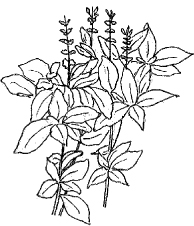
Sweet basil
HEAVENLY HERBS |
7 |
HERBS ARE SMALL PLANTS that have useful functions or useful products such as edible leaves, seeds or flowers, scented leaves for pest control, high levels of nutritious vitamins and minerals, aromas and flavor to spice meals, essential oils, medicinal uses and a myriad of other uses for our health and wellbeing.
It is easy to see why permaculture designers incorporate a range of herbs into their designs, acknowledging the important role herbs play in cultivated ecologies.
However, it is extremely difficult to pick a “top ten” of all the herbs we use and value, so I have opted for the top ones in different categories of herbs: edible, pest-repellent, medicinal and herbal teas.
Usually it is the leaves that are used in cooking and most herbs used in this way, such as rosemary and fennel, add a savory flavor to food.
Some herbs, such as tarragon and basil, do add a mild sweet flavor, but the majority of herbs are either sour or bitter. It is the oils and other aromatic chemicals in the leaves of herbs that provide the seasoning and flavors to food.
When other parts of plants are used, such as the seeds, bark or root, to provide flavoring or coloring to food, we call them spices. Spices include turmeric, cinnamon, ginger, cloves, galangal and nutmeg.
Sweet basil is the common garden variety that is traditionally used in many tomato and meat dishes, and in making pesto. Basil leaves do have a fair amount of vitamin K but not much else. The herb is used fresh in cooking as drying destroys much of the flavor.

Sweet basil
Many other varieties are used in cooking dishes and these include Thai, holy, Greek and lemon basil.
Most basil types are annuals (although in warmer climates basil may survive through winter) but you can buy a perennial basil, which can be pruned and the leaves used as required.
While the leaves of perennial basil are not used for salads, they can be added to cooked vegetable and meat dishes.
Bay leaves are used to flavor soups, meat dishes and sauces, and are a key ingredient in bouquet garni and chai tea.
While fresh leaves can be used, bay leaves develop their full flavor a week or two after picking or drying. Bay leaves are very tough even after cooking and are normally removed from the dish before eating. They are not particularly nutritious.
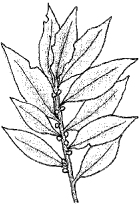
Bay leaf
» DID YOU KNOW?
Many herbs can be dried by hanging bunches in a dark, cool, well-ventilated place for a few weeks. While it is usually best to use fresh herbs, dried herbs such as bay leaf, lavender, thyme, mint and sage, still maintain some of their smell and flavor for more than a year.
There are many other trees similar to bay laurel, where the leaves are used in much the same way. These include the Californian bay tree (Umbellularia californica) and Indian bay leaf (Cinnamomum tamala).
Unlike most of the onion family, chives are a small, clumping, perennial plant and while it does have a little bulb, it is the chopped leaves that serve as a garnish and are added to soups and egg, vegetable and meat dishes.
Chives were originally found across the northern hemisphere, but are now cultivated throughout the world. In colder climates chives die back to the bulb, but sprout again when warmer weather appears.
The leaves contain considerable amounts of vitamins K, C and A, and the minerals manganese and magnesium.
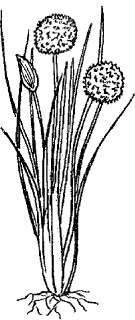
Chives
Garlic chives (Allium tuberosum), a similar species that has strappy leaves, are used in Asian cuisine.
This is an annual herb growing to about 20 in tall. Fresh leaves are added to chutneys, salads and curries, and often as a garnish on cooked food. The crushed root is used in Thai cuisine. The leaves contain high amounts of vitamins K, C, A and E (in this order) and reasonable amounts of the minerals iron, manganese and potassium.
The seeds (dry fruits) can be used whole or ground to a powder, and this spice adds an aromatic, citrus flavor to many dishes. Cilantro seed is also called coriander.
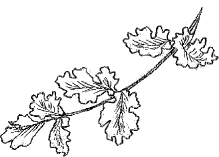
Cilantro
Common oregano is a small, perennial herb to 20 in, although in colder climates it can die off in winter. Like bay leaves, the flavor of the dried leaves is strong. However, both fresh and dried leaves are added to pizzas, tomato and meat dishes, salads and roast vegetables.
High in fiber, calcium, iron and magnesium, oregano leaves also contain many organic compounds, which vary in concentration depending on the variety or cultivar grown.
A very closely-related species, marjoram (Origanum majorana), is used like (and confused with) oregano, but it has a slightly sweeter, gentle flavor. While marjoram is used in French cooking, Italians prefer oregano.

Oregano
Parsley is high in vitamins A, C and K and is a common garnish for salads, meat and potato dishes, and soups. The curly-leaf variety (var. crispum) is more decorative than the flat-leaf variety (Italian, var. neapolitanum), but both are easy to grow from seed. In cooler climates parsley may be biennial but in warmer climates it tends to be an annual.
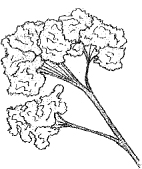
Curly-leaf parsley
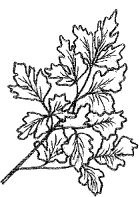
Flat-leaf parsley or Italian parsley is larger than the common curly-leaf variety.
Rosemary is a drought-tolerant, tough, woody perennial to 3–6 ft high that has a long tradition in cooking. Often a sprig is used on top or inside a roast of poultry, red meat or fish, while a few finely-chopped leaves add a tasty garnish to bread, pizza or other pastries.
A sprig or two placed in olive oil for a few weeks causes the essential oils in the rosemary leaves to permeate the oil. The leaves themselves are not nutritious but they do add a lovely favor to dishes.
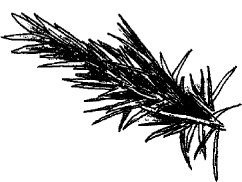
Rosemary
Summer savory is a small annual plant, growing up to 20 in tall, that is easily grown in a container, and the dried or fresh leaves flavor vinegars, soups and meat dishes. While the leaves do contain fair amounts of manganese, calcium and iron, summer savory is much better known for the peppery tang it adds to foods.
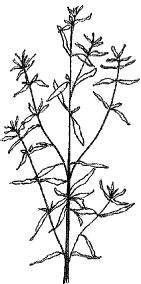
Summer savory
» DID YOU KNOW?
There are many species that belong to the “savory” family. For example, you can also use winter savory (Satureja montana), which is a perennial plant growing up to 12 in tall, and has a similar spicy flavor (although a little more bitter) to summer savory.
The most commonly used culinary variety is French tarragon. This is an aromatic, perennial herb and is used to flavor sauces, meat dishes and the occasional drink. Nutritionally very poor, tarragon oil contains several organic compounds that give it a particular anise taste.
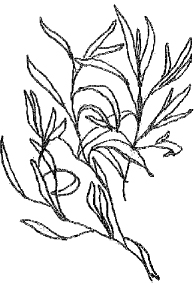
Tarragon
The tiny leaves of many thyme species are added as seasoning to omelettes or scrambled eggs and a variety of meats and sauces. Like rosemary, finely chopped or dried thyme leaves can be sprinkled onto bread dough to make a savory loaf. For a mild citrus flavor use lemon thyme (Thymus citriodorus). The leaves do not contain many nutrients, but do contain an aromatic compound called thymol that is a good antiseptic and gives thyme its strong flavor.
Many other herbs are used in cooking, and these include chervil (Anthriscus cerefolium), dill (Anethum graveolens), fennel (Foeniculum vulgare), mint (Mentha spp.) and sage (Salvia officinalis).
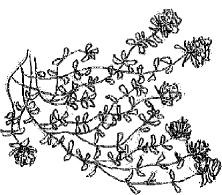
Thyme
Herbal teas are soothing, usually free from caffeine and very satisfying, fresh from your garden. Usually, three to six leaves (about one sprig or two teaspoons fresh, one teaspoon dried) are infused in boiling water for a few minutes — leave longer in the cup for a stronger flavor. You can sweeten with honey or add a slice of lemon or ginger. If you were keeping the tea for a drink later (placing it in the refrigerator), then strain to remove the leaves.
Some herbs can be used together, such as green (Chinese) tea and bergamot, lemon verbena and cinnamon, and bergamot and lemon verbena.
This perennial herb is also known as crimson beebalm, and it grows to 3 ft high. It is a hardy plant with orange-scented foliage that may help mask susceptible plants from pests. The flowers attract bees, birds and butterflies. Aromatic teas are made from fresh or dried leaves and flower heads.
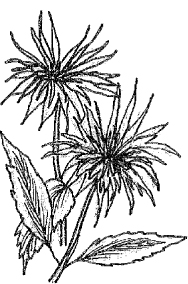
Bergamot
The dried and roasted root is ground to make a substitute for coffee. The edible leaves are high in vitamins K, A and C, and the minerals iron and manganese, and can be added to salads (although used in moderation). Older leaves are usually cooked as a vegetable.
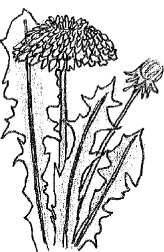
Dandelion
Other herbs can be mistaken for dandelion. Dandelion has a single flower stem while similar-looking herbs, such as catsears and hawksbeard, have multiple flowering stems.
» DID YOU KNOW?
In botany (and cooking), a “sprig” is a small piece of stem or branch with leaves attached. It is usually about 2–3 in in length but there is no exact defined length. You might cut a sprig of rosemary to add to a roast meat dish or a sprig of lavender placed in a clothes drawer to repel silverfish.
Use a teaspoon of dried flowers in a cup of boiling water. English chamomile is not as sweet as German chamomile. It is useful as a perennial herb lawn because it is a creeping ground-cover plant to 12 in high, and its leaves are finely divided and aromatic.
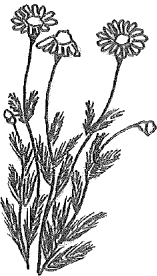
English chamomile
German chamomile is a low annual shrub with daisy-like flowers similar to English chamomile. Use fresh or dried flower heads to make tea. It is reputed to be good for calming nerves.
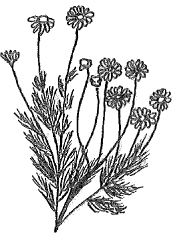
German chamomile
Ginger requires specific growing conditions as it is a tropical plant that requires rich soil, a warm, sheltered area and lots of water.
Grate or slice about half a teaspoon of ginger rhizome (underground stem) in a cup and steep with hot water. Because of its “spiciness” you normally add other ingredients such as honey or a slice of lemon or orange.
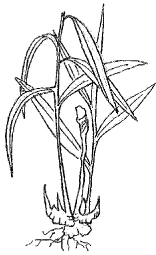
Ginger
Lemon balm is a bushy, hardy, herbaceous perennial to 3 ft that tolerates shade. The small white flowers attract bees. Use the leaves as a flavoring to fish and poultry dishes, or add in salads. Herbal tea made from an infusion of the leaves is known to reduce stress and have a calming effect.
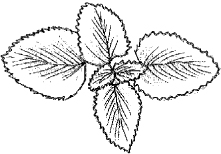
Lemon balm
Although common in tropical regions, lemongrass can be grown in other climatic zones provided it receives adequate water and shelter, especially from frosts.
There are quite a few species of Cymbopogon and some are used for the production of citronella oil (insect repellent) while others are used for cooking and making drinks. The common lemongrass (Cymbopogon citratus) is a perennial grass that has dense clumps of long, tapered leaves. The leaves are used in teas and cooking and the bulb at the base of the leaves is used in Asian cooking. Plant where it can be well watered.
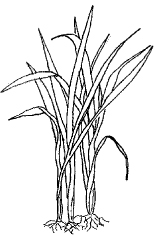
Lemongrass
» DID YOU KNOW?
The “lemon” flavor and smell of many herbal teas is due to a range of organic substances. These include citral and citronellal. Rose-scented bushes often contain geraniol or nerol, while linalool gives the sweet smell found in lavender.
A native from South America, lemon verbena is an evergreen shrub in warm, humid climates but can be deciduous in colder climates. The narrow, light green leaves give a lemon fragrance to any drink or dish. Dried leaves can also be used in sachets and sleep pillows.
After flowering each year, trim the shrub to maintain bushiness because it can become scraggly.
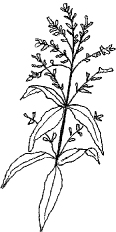
Lemon verbena
Most mint plants can be used for herbal teas, except some of the perfume varieties like eau de cologne.
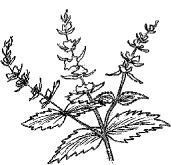
Spearmint
My favorites are peppermint (Mentha × piperata) and spearmint (Mentha spicata). Both have strong flavors and make a refreshing tea, either hot or cold. Keep the strained tea in a refrigerator or make into ice blocks.
All mint varieties need moist environments and should be contained in hanging baskets or pots, unless you want them to spread. Mints are also used to make garnishes and sauces.
Common thyme (Thymus vulgaris) is a low evergreen shrub and some varieties are ground covers. Many hybrids and cultivars exist, and most prefer sunny locations in well-drained soils. Leaves or sprigs are used in cooking, and oil is extracted from the leaves and is a known antiseptic. A tea, made from infusing the herb in water, is a refreshing drink and a useful mouthwash.
Lemon thyme (Thymus citriodorus) also has many cultivars including variegated lemon, orange and lime — all of which make great scented herbal teas.
There are many “lemon” flavored teas and if you want to try more, the Australian rainforest tree, the lemon-scented myrtle, Backhousia citriodora, is worthy.
Many scented geraniums also make good herbal teas. You will just have to experiment.
So many herbs contain oils and other chemicals that repel pests. Pest control is not only about repelling pests, it is also about attracting predators into the garden. Here are just a few common herbs that do one or the other, or both.
Fennel is one of the oldest cultivated herbs and it attracts a range of predators as well as repelling fleas and other pests. However, it is better known for its culinary uses (the leaves, bulb and seeds are eaten).
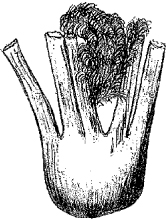
Fennel bulb
When planted around a tree or food crop, garlic is said to repel borers, mites and other sap suckers.
Rich in organic compounds that give it its characteristic odor, garlic (along with most other alliums like onions and leeks) has traditionally been used for pest control, as well as having medicinal and culinary uses.
Common lavender (Lavandula angustifolia) and lavender oil are very effective insect repellents.
Lavender leaves and oil keep moths away from clothes, weevils from cupboards and fleas from pets and carpets. Common lavender is an attractive perennial shrub with mauve (or occasionally white) flowers.
Lavender is a hardy perennial that is reasonably drought tolerant. There are many varieties and one of my favorites is green lavender (L. viridis), which also has a yellow variety.
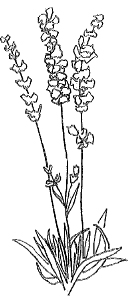
Lavender
» DID YOU KNOW?
Some flower shapes attract predatory and parasitic insects. Particular flowers may be shallow and contain both nectar and pollen, so predatory insects, such as hoverflies, wasps and ladybugs, can obtain immediate energy while they hunt for bugs to eat. Other plants, such as fennel, coriander and dill, have flower clusters called umbels (that resemble upside-down umbrellas), which are open nectaries offering insects easier access to nectar.
Nasturtiums are rambling ground cover plants. Their yellow, red and orange flowers and green leaves are reputed to repel aphids and red spider mites from nearby plants. All nasturtiums have mustard scented foliage and both the leaves and flowers are edible. We can eat the seeds as a substitute for capers.
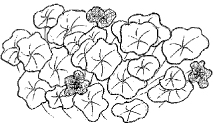
Nasturtium
Pyrethrum is a small, hardy, perennial bush widely used in organic pest control products.
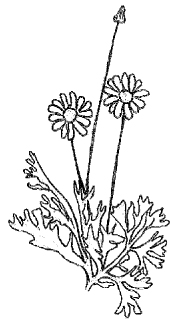
Pyrethrum
To make an insect spray, cover chopped flowers with mineral oil and soak overnight in a dark place. Strain and store in a cool dark place. To make up the spray, add to the concentrate six parts of water and a few drops of sesame, or another similar, oil.
Pyrethrum spray has low toxicity and is biodegradable. It doesn’t keep well so use it all within a few days of making.
While rue can be used in culinary food dishes and to treat a host of medical conditions, it is also used for pest control. Rue is reputed to repel fleas, flies and beetles, and it attracts predatory insects into the garden.
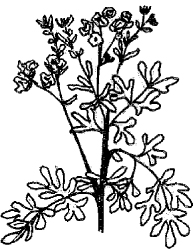
Rue
Santolina is an attractive, compact, small shrub with gray foliage and yellow button-like flowers. It prefers well-drained soil, tolerates full sun and is drought hardy. The leaves are used to repel moths (in clothing drawers and pantry shelves). Both the leaves (fresh or dried) and sprigs are suitable.
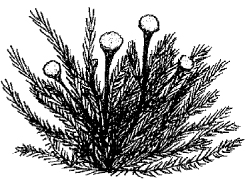
Santolina
There is a wide variety of scented geraniums available. They are all good, general pest repellents as pests are deterred by the strong smell of their leaves. Some scented geraniums can also be used in herbal teas and to add flavor in cooking.
Scented geraniums grow best in well-drained, fertile soil in full sun but can withstand dry conditions quite well.
The leaves from various lemon-scented pelargoniums (containing citronella oil) can be rubbed on the skin to deter mosquitoes. Scented geraniums are often confused with true geraniums (or cranesbill), but while the two types of plants are related, they are distinctly different.
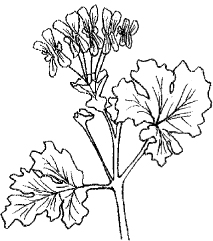
Scented pelargonium
Tansy is a small, perennial herb that can be invasive as it has spreading underground rhizomes. Although tansy has both culinary and medical uses, it is primarily used as a repellent for flies, fleas and ants. Tansy oil contains several aromatic substances that repel pests and has fungicidal and antibacterial properties. The leaves are rich in nutrients and can be used as a catalyst in compost making.
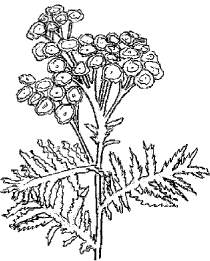
Tansy
True wormwood (Artemisia absinthium), a shrub to 6 ft, has been used for centuries as a pest repellent. Sprigs can be left in the nesting boxes of chickens (to repel lice) or wormwood “teas” can be sprayed on vegetables to repel snails, moths and other pests. It is often ingested by birds and animals to deworm intestinal tracts, but is toxic to humans if consumed.
Roman wormwood (Artemisia pontica), sea wormwood (A. martima) and southernwood (A. abrotanum) can all be used for pest control but are less potent.
Many other herbs repel insects and other pests and these include balm of Gilead, elderberry, catnip, dogbane, mint, marigold, rosemary and basil.
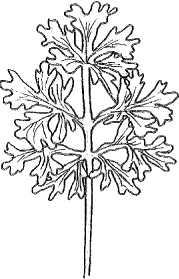
Wormwood
Consult any herb book or website and you will find an exhaustive list of the greatest ever medicinal herbs. Unfortunately, many are not readily available from your local nursery, or allowed in some countries or shipped between some states. Some are even declared as noxious weeds. So herbs like ginseng, burdock, wild quinine, St John’s wort, mullein and great yellow gentian are not discussed here.
The neem tree (Azadirachta indica) is an amazing medicinal plant, and scientific studies have shown that it is a powerful pesticide, bactericide and fungicide, and can be used to treat ulcers. Unfortunately it is a large tree, and difficult to grow outside of tropical regions.
So we need to find universal plants that survive in a wide range of soils and climates, or plants small enough to be looked after in warm and sheltered places.
Some plants such as aloe vera have folklore medicinal uses but scientific studies have not fully supported the “magical” gel that is commonly used in drinks, creams and lotions.
While I can attest to successfully using the gel on burns and cuts, there doesn’t appear to be much evidence supporting its healing powers. The same can be said for comfrey, ginkgo, calendula, sage and vervain and the vast majority of herbs for that matter.
There has been considerable research into the different types of organic substances found in herbs, possibly due to researchers trying to discover new compounds or the ultimate cure for AIDS or cancer. Not much research, surprisingly, has been done on the herb itself for its action to treat diseases and conditions.
The following herbs are common enough for the home garden and some of these are also edible. If you wish to try and use these plants you should consult other sources to see how they are best prepared.
For some plants, the flowers or fruits contain active ingredients while for other plants the leaves or both the flowers and leaves are utilized.
Cayenne pepper is a variety of the common chili pepper and bell pepper. It is a “hot” variety that is typically red in color, and contains the active ingredient capsaicin. Capsaicin has been shown to reduce pain, especially for those suffering from shingles or recovering after operations.
The powdered form of various types of peppers is called paprika.
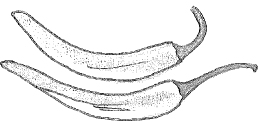
Cayenne pepper
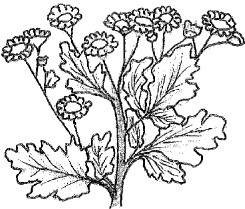
Feverfew
There is good evidence that feverfew relieves migraines and headaches, although it doesn’t seem to relieve fever as the name suggests. A couple of leaves are normally eaten, but these can be bitter, so it is best to consume them with some other food. Feverfew is believed to be a preventative treatment, so eating these daily is a worthwhile strategy for those who suffer frequent migraines. Some people simply sniff the flowers and leaves, as feverfew has a very distinct odor.
» DID YOU KNOW?
Whenever scientific and medical studies are undertaken it is essential that the participants (subjects) do not know whether they are given the drug or herbal extract or whether they have the placebo (some harmless substance). All those that are given the placebo believe they are taking the drug. This is called a blind or blinded experiment. When the researchers are also unaware of what medicine is the drug and what is harmless, this is called a double blinded experiment. This is normal practice in medical research and these types of clinical trials establish if a particular herbal medicine has any meaningful results.
Peppermint oil has been shown to improve digestive disorders, such as irritable bowel syndrome, and spasms in the intestines and stomach. Peppermint leaves can be used to make a tea but the oil is usually extracted by steam distillation of the leaves. The oil contains many compounds with menthol being the main ingredient. Peppermint oil has also exhibited antibacterial and antiviral properties and has been used to treat bad breath and dandruff.
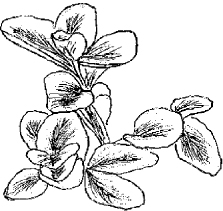
Peppermint
Tea tree is an Australian shrub or small tree that can be pruned to maintain a compact size. The oil from the leaves has been shown to be reasonably effective against fungal infections, such as athlete’s foot. It is an effective antibacterial agent and a useful disinfectant.
There is some evidence that it is also effective in the treatment of other skin infections such as acne, warts and vaginal infections. Tea tree oil has been shown to alleviate inflammation and itching from dandruff.
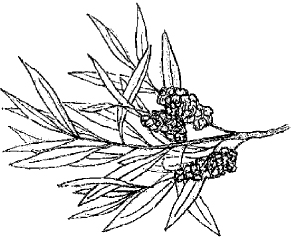
Tea tree
The leaves of many Australian native plants contain oils with proven antiseptic (kills germs), antifungal and anti-inflammatory properties. These plants include species of melaleuca, eucalyptus, callistemon and kunzea.
Yarrow is a small, perennial plant with white flowers and a vigorous, spreading root system. Common garden cultivars can also have yellow or red flowers.
Yarrow leaves grow from underground rhizomes and are feathery and aromatic.
Yarrow oil has been shown to have antibacterial and antifungal properties and there is some evidence that yarrow extracts help with wound healing.
As more research is undertaken on the numerous beneficial properties of common herbs, by exploring their traditional uses in many cultures throughout the world, more herbs and their products can be added to the home medical cabinet.
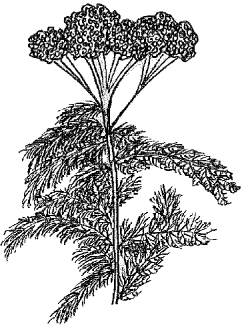
Yarrow